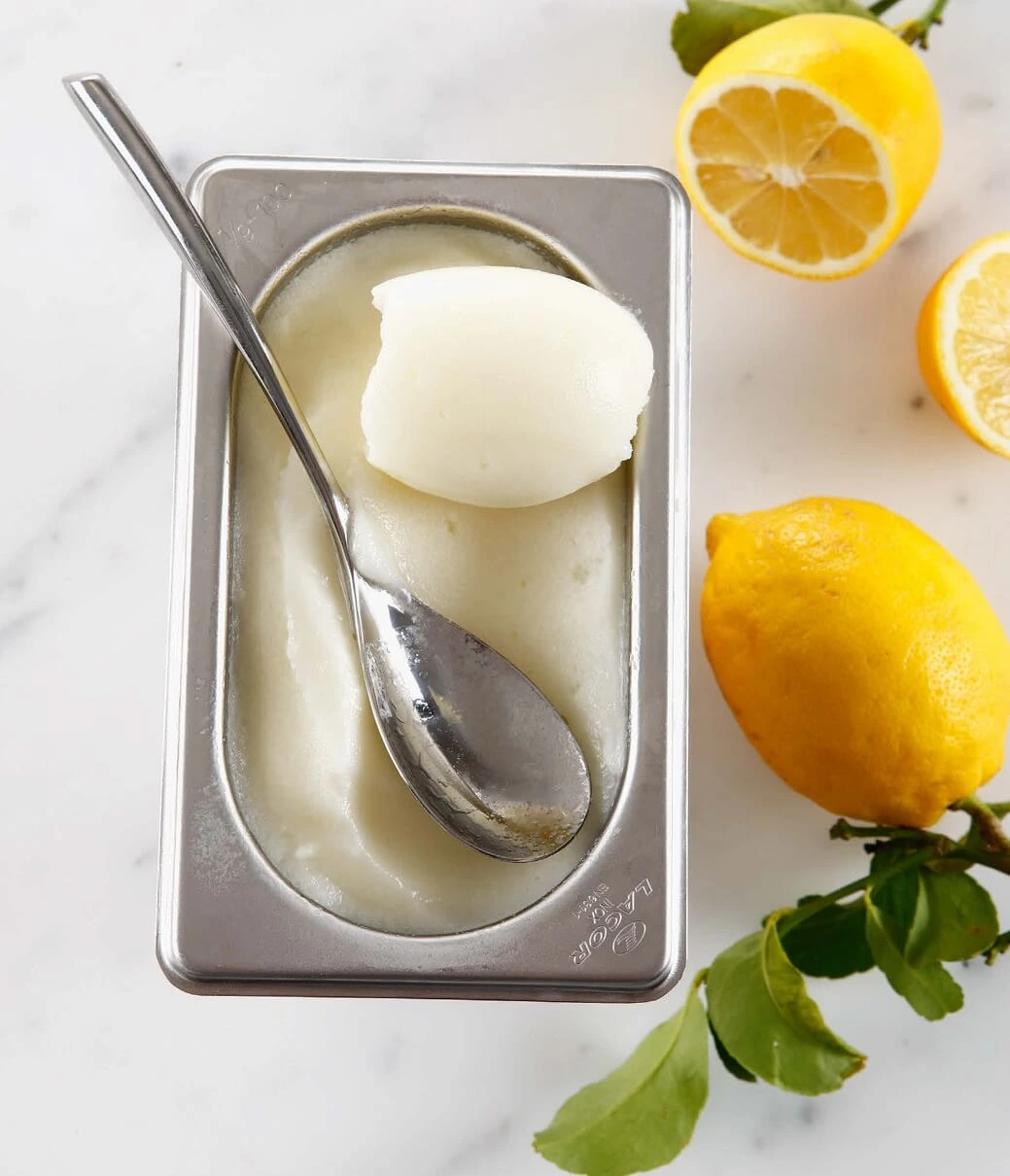Lemon sorbet is the very essence of refreshing elegance, capturing the bright and delicate flavors of citrus in a silky, airy texture that melts effortlessly on the palate. It’s the perfect finale to a meal or a cooling treat on a warm day, balancing tangy sharpness with subtle sweetness.
Crafting this sorbet is an exercise in harmony, where the natural acidity of fresh lemons is gently softened by a touch of sweetness to awaken the taste buds with a lively yet refined burst of flavor. The fragrant zest adds an aromatic layer, evoking the freshness of sunny orchards and a light breeze.
The texture is key — smooth and finely textured, often lightened with a bit of air to create a creamy yet refreshing mouthfeel. It holds its form well, firm enough to be scooped yet supple enough to glide on the tongue.
Presented in a graceful serving dish, sometimes adorned with a fresh mint leaf or a delicate lemon twist, lemon sorbet becomes more than just a dessert — it’s a celebration of simplicity and sophistication, perfect for those who crave a bright, clean, and invigorating finish.
Lemon Sorbet – Complete Recipe Sheet
Serves 6 to 8
Timing
- Preparation: 30 minutes
- Maturation: 4 hours (chilling)
- Storage: Up to 2 weeks in the freezer
Equipment Needed
- Kitchen thermometer
- Immersion blender (or regular blender)
- Ice cream maker (turbine)
- Freezer-safe container
Ingredients
- 35 g atomized glucose
- 25.5 g dextrose
- 5 g stabilizer for sorbet
- 9 g skimmed milk powder (0% fat)
- 191 g sucrose (regular sugar)
- 398 g water
- 332 g fresh yellow lemon juice
Preparation Steps
1. Prepare the base syrup
- In a saucepan, combine water, sucrose, atomized glucose, dextrose, stabilizer, and milk powder.
- Heat gently over medium heat while stirring regularly until all sugars and powders fully dissolve.
- Use the thermometer to monitor temperature and keep it around 45-50°C (113-122°F).
- Do not exceed 50°C to preserve the qualities of the stabilizer and powders.
2. Add the lemon juice
- Remove the saucepan from heat.
- Add the fresh lemon juice and blend with the immersion blender to fully homogenize the mixture and incorporate some air for a lighter texture.
- The mixture should be smooth and free of lumps.
3. Maturation
- Pour the mixture into a clean container and cover.
- Let it rest in the refrigerator for at least 4 hours. This step enhances flavor development and improves texture.
4. Churning
- After maturation, pour the mixture into your ice cream maker.
- Churn for about 30 minutes or until you reach a creamy, firm sorbet consistency.
- Keep an eye on the texture to avoid over-freezing.
5. Storage
- Transfer the sorbet to a freezer-safe container with a tight lid.
- Store in the freezer for up to 2 weeks.
- Before serving, let the sorbet sit at room temperature for 10 to 15 minutes for easier scooping.
Chef’s Tips
- Use fresh, juicy lemons for an intense and natural flavor.
- The stabilizer is key to preventing ice crystals and keeping a smooth texture.
- The immersion blender helps incorporate air, making the sorbet lighter.
- Glucose and dextrose improve texture by preventing the sorbet from freezing too hard.
Detailed Lemon Sorbet Preparation
1. Mixing the powders
Begin by combining all the dry ingredients: atomized glucose, dextrose, sorbet stabilizer, skimmed milk powder, and sucrose (table sugar). Thoroughly mix these powders together to ensure an even distribution. This step is crucial for the powders to dissolve properly during cooking, which will result in a smooth, consistent texture in the final sorbet. Take your time to mix well and avoid any lumps that could affect the sorbet’s quality.
2. Heating the water and adding powders
Pour the water into a clean saucepan and start heating it gently over medium heat. Use a kitchen thermometer to monitor the temperature carefully. Once it reaches about 40°C (104°F), add the powder mixture slowly while stirring continuously with a whisk or wooden spoon. This gradual addition and moderate temperature allow the powders to dissolve evenly without burning or sticking to the pan. Then, raise the heat and bring the mixture to a boil. Boiling activates the stabilizer and ensures all sugars are fully dissolved, which is essential for the sorbet’s texture.
3. Adding the lemon juice and blending
Once boiling is reached and the powders are fully dissolved, remove the saucepan from the heat. Let the mixture cool slightly for a few minutes to avoid degrading the fresh lemon aroma. Pour in the freshly squeezed yellow lemon juice while the mixture is still warm. Use an immersion blender to thoroughly mix the preparation. This step homogenizes the mixture and incorporates a bit of air, which will lighten the sorbet’s texture. The final liquid should be smooth, uniform, and free of any pulp or lumps.
4. Cooling and maturation
After blending, transfer the mixture into a suitable container (preferably stainless steel or glass) and cover it. Place it in the refrigerator to cool down completely and allow the flavors to mature. Let it rest for at least 4 hours. This maturation phase is essential: it deepens the lemon flavor, balances the acidity, and stabilizes the texture before churning. Slow cooling also prevents the formation of large ice crystals that would make the sorbet grainy.
5. Second blending and churning
After the maturation time, take the mixture out of the fridge. For optimal texture and consistency, give it another quick blend with the immersion blender to re-incorporate any settled ingredients and smooth out the mix. Then pour the liquid into your ice cream maker (turbine), following the manufacturer’s instructions carefully. Churn for about 30 minutes or until the sorbet reaches a creamy, firm consistency. During this stage, the constant stirring and freezing create the signature light and smooth texture.
6. Transferring and blast freezing
Once churned, immediately transfer the sorbet into a clean, dry freezer-safe container. Smooth the surface evenly with a spatula to create a flat finish. This not only makes for a nice presentation but also helps with even freezing. Place the container in a blast freezer or set your freezer to a very low temperature around −35°C (−31°F) for rapid freezing. This quick freezing step is critical to lock in the smooth texture and avoid large ice crystals forming.
7. Final storage
After the initial blast freeze, store the sorbet at a stable temperature of −20°C (−4°F) for up to two weeks. This standard freezer temperature preserves the sorbet’s flavor and texture. Before serving, remove the sorbet from the freezer about 10 to 15 minutes in advance to soften it slightly for easier scooping.
Summary
This detailed, professional method ensures a lemon sorbet with perfect texture, balanced flavor, and excellent shelf life. Each step is designed to maximize the freshness and smoothness—from powder mixing to blast freezing.
Conclusion
Lemon sorbet, with its smooth texture and intense freshness, is a light and refreshing dessert that delights the palate every time. Making it requires some skill—especially in controlling temperatures and respecting the maturation stages—but the results are well worth the effort. By mastering the balance of sugars, properly mixing the powders, and carefully churning, you’ll create a sorbet worthy of the finest ice cream shops—both indulgent and subtle. Don’t hesitate to experiment with high-quality fresh lemons and follow the maturation and blast freezing steps closely for a perfectly smooth and creamy sorbet.
Questions & Answers
Q: Why is it important to mix the powders before adding them to the water?
A: Mixing the powders ensures they dissolve evenly during heating, preventing lumps and resulting in a smooth, uniform sorbet texture.
Q: What is the purpose of the maturation step in the fridge?
A: Maturation allows the flavors to fully develop and the texture to stabilize. It also helps prevent large ice crystals from forming during freezing.
Q: Can I use bottled lemon juice instead of fresh lemon juice?
A: For the best quality sorbet, fresh lemon juice is recommended because it contains more natural, intense flavors compared to pasteurized bottled juice.
Q: What does the stabilizer do in the sorbet?
A: The stabilizer prevents the formation of large ice crystals, making the texture smoother and more enjoyable. It also helps maintain the sorbet’s consistency over time.
Q: How long can I store the sorbet in the freezer?
A: The sorbet can be stored for up to two weeks at a consistent −20 °C (−4 °F) without significant loss of quality.

